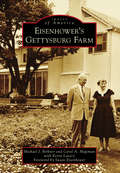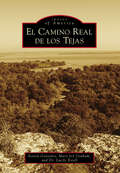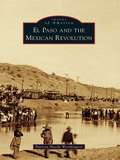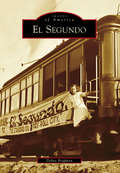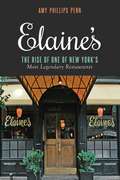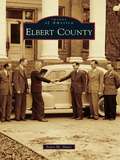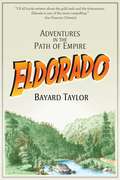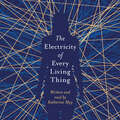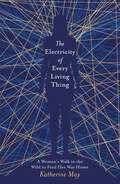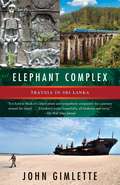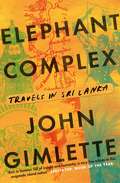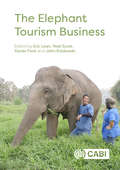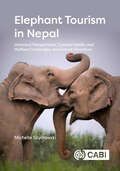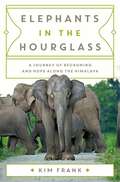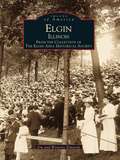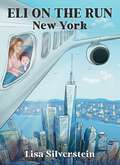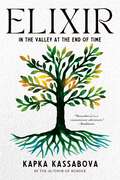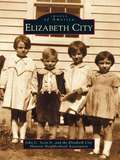- Table View
- List View
Eisenhower’s Gettysburg Farm (Images of America)
by Michael J. Birkner Carol A. Lavery Foreword By EisenhowerThe Eisenhower farm was the first and only home that Dwight Eisenhower and his wife, Mamie, called their own. During Eisenhower’s military career, he and Mamie lived around the world, but he always hoped to own a piece of property and leave it better than he found it. That wish led to the purchase of the Allen Redding farm in 1950 and the Eisenhowers’ thorough renovation of its dwelling. During Eisenhower’s presidency, the farm served as a retreat from the Washington pressure cooker. When his presidential term ended, the Eisenhowers embraced a new chapter in their lives together. Eisenhower maintained an active schedule of writing, speechmaking, correspondence, and meetings with a wide range of national and world leaders, as well as supervision of an active farm operation. Mamie and Dwight shared a busy social life in retirement, taking special pleasure in spending time with their son John, daughter-in-law Barbara, and four grandchildren. This book tells the Eisenhowers’ Gettysburg story.
El Camino Real de los Tejas
by Dr Lucile Estell Mary Joy Graham Steven GonzalesThe Royal Road of the Tejas Indians, El Camino Real de los Tejas, was born hundreds of years ago when the Native Americans followed routes used by buffalo and other animals, realizing that these early creatures knew the best paths to take. Also known as Kings Highway, it later became a major thoroughfare used by travelers from the East coming to Louisiana, Texas, and Mexico. In 2004, El Camino Real de los Tejas took on new meaning when the historical road was designated as the 19th National Historic Trail in the United States. Development is guided by El Camino Real de los Tejas National Historic Trail Association housed in Austin, Texas.
El Paso and the Mexican Revolution (Images of America)
by Patricia Haesly WorthingtonThe Mexican Revolution took place along the entire length of the border between the United States and Mexico. Most of the intense battles and revolutionary intrigue, however, were concentrated in the border region of El Paso, Texas, and Ciudad Juárez, Mexico. For 20 years, the U.S. and Mexico border communities dealt with revolution, beginning before the 1909 Taft-Díaz visit and ending with the Escobar Revolution of 1929. In between were battles, assassinations, invasions, and attempts at diplomacy. El Paso was center stage for many of these events. Newspapers and media from all over the country flocked to the border and produced numerous stories, photographs, and colorful renditions of the Mexican Revolution. The facts and myths have been kept alive over the last 100 years, and the revolution remains an important topic of discussion today.
El Salvador at War: An Oral History of Conflict from the 1979 Insurrection to the Present
by Max G. Manwaring Court PriskTO UNDERSTAND INSURGENT conflict in the Third World, Americans must recognize the nature of the struggle between totalitarianism and democracy. The insurgency in El Salvador in the 1980s is not a mass movement, but a carefully scripted strategy executed by an educated and disciplined elite. This insurgent group is not in revolt against a government or its military, per se. Rather it is reacting against corruption, racial and religious discrimination, foreign intervention, and inability or unwillingness of a government to protect and be responsible to the general population. The revolutionary elite uses political, economic, and social grievances as justification for its actions. This struggle between insurgent and incumbent is over who has the moral right to govern. Such is the probable nature of future conflict, and it is with that understanding that any appropriate response must begin.El Salvador at War is an oral history of the Salvadoran struggle. In an illuminating departure from conventional histories of war, Max Manwaring and Court Prisk trace the major contours of the conflict. Their book tells what key individuals think about the war, what the really important lessons are, and what the participants should have learned. It is their perspective, their truth, recorded here—what a number of the key participants see as historical fact and a basis for action.Studying the fundamental nature of insurgent conflict is key to understanding this most prevalent form of twentieth-century conventional war. In examining insurgent conflict, El Salvador at War offers some new insights into our role in contemporary international security.
El Segundo (Images of America)
by Debra BrightonBy 1885, Daniel Freeman owned a successful 25,000-acre ranch along the coastline in Southern California. That year, he sold parcels to J.S. Vosberg, and this became the site of the town of El Segundo. The Standard Oil Company of California purchased 840 acres of dunes in June 1911, and R.J. Hanna was hired to construct and manage the new refinery. His wife is credited with naming the town El Segundo ("the second"), as it was the location of the second Standard Oil plant. The city quickly expanded and was incorporated on January 18, 1917. From an early oil town to the "Aerospace Capital of the World" in the mid-1950s, El Segundo today includes a thriving residential community as well as several Fortune 500 corporations, an Air Force base, and the Chevron El Segundo Refinery.
Elaine's: The Rise of One of New York’s Most Legendary Restaurants
by Amy Phillips PennA tribute to legendary restaurateur Elaine Kaufman and her renowned Manhattan creative melting pot. Elaine’s was a world-famous New York restaurant that became home to writers and celebrities. Owner Elaine Kaufman was known to be "New York feisty,” controversial, often rude, always blunt, with the flare of Gertrude Stein and Dorothy Parker. Elaine was highly respected and also frequently feared, and Elaine’s the restaurant received the public’s love and praise time and time again. Woody Allen held a regular table there, and Elaine’s was even featured in Allen’s Manhattan and Billy Joel’s song "Big Shot. ” Throughout the years, Mick Jagger, John Lennon, and countless celebrities, politicians, socialites, private eyes, athletes, artists, and the biggest names in Hollywood became Elaine’s regulars. Most emphatically, Elaine’s raison d’être was to nourish "starving writers” with encouragement, introductions to Pulitzer Prize winners, and free food and alcohol. These struggling authors responded to Elaine’s support with profound gratitude. Elaine passed away in 2010, forcing the restaurant manager to close shop shortly after. "There is no Elaine’s without Elaine,” she decreed. However, the memories remain and are recalled by a variety of Elaine’s regulars in this moving, oftentimes amusing, collection of personal essays. Skyhorse Publishing, as well as our Arcade imprint, are proud to publish a broad range of books for readers interested in history--books about World War II, the Third Reich, Hitler and his henchmen, the JFK assassination, conspiracies, the American Civil War, the American Revolution, gladiators, Vikings, ancient Rome, medieval times, the old West, and much more. While not every title we publish becomes a New York Times bestseller or a national bestseller, we are committed to books on subjects that are sometimes overlooked and to authors whose work might not otherwise find a home.
Elbert County (Images of America)
by Joyce M. DavisEstablished in 1790, Elbert County was carved from adjacent Wilkes County and named in honor of American patriot and former governor Samuel Elbert. Located in Northeast Georgia on the Savannah and Broad Rivers, the territory witnessed Revolutionary War fighting and the creation of Fort James, Dartmouth, and Petersburg, occurring all before 1790. Later Ruckersville, Heardmont, Bowman, and Dewy Rose were established. Elberton, chosen as county seat by former governor Stephen Heard's committee, was incorporated in 1803 and dominated county history thereafter. Nancy Hart and Stephen Heard, among others, aided the revolution; merchants William and Beverly Allen forged a business path; and preachers, including Dozier Thornton, established many county churches. In later years, Corra Harris, born at Farmhill, attended Elberton Female Academy before becoming a noted writer. In the 20th century, cotton production was overshadowed by the growth of granite quarrying and finishing, leading to Elberton becoming the "Granite Capital of the World."
Eldorado: Adventures in the Path of Empire (Notable American Authors)
by Bayard TaylorA journalist's eyewitness account of the explosive 1849 California gold rush and his travels through Mexico. In 1849, a young, wide-eyed reporter from New York ventured West not to seek riches, but to report on the madness and exuberance of the California gold rush. Sent by Horace Greeley, a highly respected New-York Tribune editor, twenty-four-year-old Bayard Taylor traveled through Panama to reach his final destination, San Francisco, which he described as an "amphitheatre of fire" in the night, gleaming with the promise of gold and progress.In his enthralling and robust narrative, Bayard brings the reader into the wild, lush world of early California, reporting on the nearly overnight growth of townships and infrastructure after the gold rush. During his adventures, Bayard walked one hundred miles from San Francisco to Monterey, and later returned to New York via Mexico by foot, mule, and coach. Bayard describes the characters he met with an honest curiosity--heady gold miners who had once been doctors and lawyers, hospitable Mexicans from all classes of society, and even a highway robber who made off with his books.Eldorado, which borrows its title from the South American-Spanish legend of a hidden land of gold, is a magnificent tale about the birth of California from a deserted land to a modern city sprawl. At once an account of history and of one man's thrilling adventures, Eldorado transports the reader to the beginning of an era, with all its gold, glitz, and glamour.
The Electricity of Every Living Thing: A Woman's Walk in the Wild to Find Her Way Home
by Katherine MayLast summer, Katherine May was approaching 40, feeling overwhelmed by motherhood and lacking connection with others, lost in a world of inundation and expectation. She had always felt different but this feeling was new. She wanted to get out, get free and find herself again - and so set about walking the rugged 450 mile South West Coast Path. However, this journey uncovers more than she ever imagined. By chance, en route to the walk, Katherine hears a radio show and the guests are speaking about Asperger's Syndrome. Things begin to fall into place - could this explain the white-outs, the excruciating confusion around social contact, the electric feeling of every living thing?After a formal diagnosis, Katherine begins to unravel this new perspective of her life. Through her physical journey comes an emotional one - of accepting who she is and moving forward. It's not just about walking or Asperger's; this is one woman's journey to feel free within herself, something that everyone can relate to.Read by Nathalie Buscombe(p) Orion Publishing Group 2018
The Electricity of Every Living Thing: From the bestselling author of Wintering
by Katherine MayFrom the bestselling author of Wintering, Katherine May, The Electricity of Every Living Thing is a life-affirming and poignant exploration of nature, and how reconnecting to wild landscapes can create peace in our unquiet minds.'A windswept tale, beautifully told' Raynor Winn, author of The Salt Path 'A manifesto for the value of difficult people. I loved it' Amy Liptrot, author of The OutrunIn August 2015, Katherine May set out to walk the 630-mile South West Coast Path. She wanted to understand why she had stopped coping with everyday life; why motherhood had been so overwhelming and isolating, and why the world felt full of inundation and expectations she can't meet. Setting her feet down on the rugged and difficult path by the sea, the answer begins to unfold.The Electricity of Every Living Thing tells the story of the year in which Katherine comes to terms with a diagnosis which shakes her to her core. It leads to a re-evaluation of her life so far - a kinder one, which finally allows her to be different rather than simply awkward, arrogant or unfeeling. The physical and psychological journeys become inextricably entwined, and as Katherine finds her way across the untameable coast, she also finds the way to herself.What readers are saying about The Electricity of Every Living Thing:'Honest and sensitive' 'The astonishing sensitivity and awareness in her writing, both about the beautiful landscapes and nature around on her walks, and in relation to her family, friends and self put paid to many outdated myths about what it is like to be autistic''Compelling and transformative. I could not put this book down so I stayed in bed and read it in one go.''Katherine has a fantastic way with words, I could read her books for hours on end, they are calming and relatable.''Read it - you won't regret it.'
Elephant Butte Dam
by Cindy Carpenter Sherry FletcherOn November 18, 1904, engineer B.M. Hall submitted his final report to the 12th National Irrigation Congress in El Paso, Texas. He concluded that the ideal location for a dam and reservoir would be a site in western New Mexico. A congressional act of February 25, 1905, authorized the construction of Elephant Butte Dam, the first civil engineering structure concerned with international allocation of water. Part of the Rio Grande Project, the dam and its reservoir would provide irrigation water for farmers along the Rio Grande in New Mexico, Texas, and Mexico. Today, Elephant Butte Dam is designated as a National Historical Engineer Landmark by the American Society of Civil Engineers (ASCE), the oldest national professional engineering society in the United States. The area is home to Elephant Butte Lake State Park, where camping, fishing, and water sports are enjoyed by both residents and tourists.
Elephant Complex
by John GimletteNo one sees the world quite like John Gimlette. As The New York Times once noted, "he writes with enormous wit, indignation, and a heightened sense of the absurd." Writing for both the adventurer and the armchair traveler, he has an eye for unusually telling detail, a sense of wonder, and compelling curiosity for the inside story. This time, he travels to Sri Lanka, a country only now emerging from twenty-six years of civil war. Delving deep into the nation's story, Gimlette provides us with an astonishing, multifaceted portrait of the island today. His travels reveal the country as never before. Beginning in the exuberant capital, Colombo ("a hint of anarchy everywhere"), he ventures out in all directions: to the dry zones where the island's 5,800 wild elephants congregate around ancient reservoirs; through cinnamon country with its Portuguese forts; to the "Bible Belt" of Buddhism--the tsunami-ravaged southeast coast; then up into the great green highlands ("the garden in the sky") and Kandy, the country's eccentric, aristocratic Shangri-la. Along the way, a wild and often desperate history takes shape, a tale of great colonies (Arab, Portuguese, British, and Dutch) and of the cultural divisions that still divide this society. Before long, we're in Jaffna and the Vanni, crucibles of the recent conflict. These areas--the hottest, driest, and least hospitable--have been utterly devastated by war and are only now struggling to their feet.But this is also a story of friendship and remarkable encounters. In the course of his journey, Gimlette meets farmers, war heroes, ancient tribesmen, world-class cricketers, terrorists, a former president, old planters, survivors of great massacres--and perhaps some of their perpetrators. That's to say nothing of the island's beguiling fauna: elephants, crocodiles, snakes, storks, and the greatest concentration of leopards on Earth. Here is a land of extravagant beauty and profound devastation, of ingenuity and catastrophe, possessed of both a volatile past and an uncertain future--a place capable of being at once heavenly and hellish--all brought to vibrant, fascinating life here on the page.From the Hardcover edition.
Elephant Complex: Travels in Sri Lanka
by John GimletteNo one sees the world quite like John Gimlette. As The New York Times once noted, “he writes with enormous wit, indignation, and a heightened sense of the absurd.” Writing for both the adventurer and the armchair traveler, he has an eye for unusually telling detail, a sense of wonder, and compelling curiosity for the inside story. This time, he travels to Sri Lanka, a country only now emerging from twenty-six years of civil war. Delving deep into the nation’s story, Gimlette provides us with an astonishing, multifaceted portrait of the island today. His travels reveal the country as never before. Beginning in the exuberant capital, Colombo (“a hint of anarchy everywhere”), he ventures out in all directions: to the dry zones where the island’s 5,800 wild elephants congregate around ancient reservoirs; through cinnamon country with its Portuguese forts; to the “Bible Belt” of Buddhism—the tsunami-ravaged southeast coast; then up into the great green highlands (“the garden in the sky”) and Kandy, the country’s eccentric, aristocratic Shangri-la. Along the way, a wild and often desperate history takes shape, a tale of great colonies (Arab, Portuguese, British, and Dutch) and of the cultural divisions that still divide this society. Before long, we’re in Jaffna and the Vanni, crucibles of the recent conflict. These areas—the hottest, driest, and least hospitable—have been utterly devastated by war and are only now struggling to their feet.But this is also a story of friendship and remarkable encounters. In the course of his journey, Gimlette meets farmers, war heroes, ancient tribesmen, world-class cricketers, terrorists, a former president, old planters, survivors of great massacres—and perhaps some of their perpetrators. That’s to say nothing of the island’s beguiling fauna: elephants, crocodiles, snakes, storks, and the greatest concentration of leopards on Earth. Here is a land of extravagant beauty and profound devastation, of ingenuity and catastrophe, possessed of both a volatile past and an uncertain future—a place capable of being at once heavenly and hellish—all brought to vibrant, fascinating life here on the page.From the Hardcover edition.
Elephant Complex: Travels In Sri Lanka
by John GimletteA gripping account of an under-reported island' Spectator, Book of the Year '[A] brilliant new book about an island that has a geography from heaven and a history from hell' Daily Telegraph'A brilliant work of travel, history and psychological insight . . . astute and sympathetic . . . very funny' Wall Street Journal Everyone has wanted a piece of paradiseJohn Gimlette - winner of the Dolman Prize and the Shiva Naipaul Prize for Travel Writing - is the kind of traveller you'd want by your side. Whether hacking a centuries-old path through the jungle, interrogating the surviving members of the Tamil Tigers or observing the stranger social mores of Colombo's city life, he brings his own unique insight to the page: a treasure-chest of research and a gift for wry amusement. Through him, Sri Lanka - all at once dazzling, strange, conflicted and beautiful - comes to life as never before.
Elephant Complex: Travels In Sri Lanka
by John GimletteA gripping account of an under-reported island' Spectator, Book of the Year '[A] brilliant new book about an island that has a geography from heaven and a history from hell' Daily Telegraph'A brilliant work of travel, history and psychological insight . . . astute and sympathetic . . . very funny' Wall Street JournalEveryone has wanted a piece of paradiseJohn Gimlette - winner of the Dolman Prize and the Shiva Naipaul Prize for Travel Writing - is the kind of traveller you'd want by your side. Whether hacking a centuries-old path through the jungle, interrogating the surviving members of the Tamil Tigers or observing the stranger social mores of Colombo's city life, he brings his own unique insight to the page: a treasure-chest of research and a gift for wry amusement. Through him, Sri Lanka - all at once dazzling, strange, conflicted and beautiful - comes to life as never before.
The Elephant Tourism Business
by Ann Suwaree Ashton Liv Baker Sumanth Bindumadhav Sarah Blaine Eric Brymer Naphawan Chantradoan Saranphat Chotmanakul Qingming Cui Susanna Curtin Charlotte Day Nilakshi Galahitiyawe Vivek Gurusamy Professor Xavier Font Nicole Hausler Jeffrey Dale Hobbs Claire Jenkinson Professor John Koldowski Naut Kusters Eric Laws Shilpa Mahbubani Andrew McLean Mucha Mkono Somyot Ongkhluap Anja Pabel Piengpen Na Pattalung Clive Phillips Kannapa Pongponrat Bongkosh Rittichainuwat John Edward Roberts Andrea Saayman Melville Saayman Jan Schmidt-Burbach Professor Noel Scott Alokparna Sengupta Vinathe Sharma-Brymer Ramona Strödecke Daminda Sumanapala Daniel Turner Marjorie Van Strein Rebecca Winkler Isabelle Wolf Honggang XuElephant tourism is a growing activity in many countries across Asia and Africa and is popular with tourists from all parts of the world. Elephant tourism has grown rapidly, providing the only viable way for elephants and their owners to survive since the banning of logging. Old logging camps have been developed into sanctuaries for some elephants, but many other camps were established as entertainment centres, resulting in serious welfare issues for the elephants and their mahouts. The profits from elephant tourism in Asia have encouraged African operators to follow a similar business model. This book draws attention to the need for a comprehensive and rigorous focus on local solutions to improve the welfare of captive elephants, their mahouts and local residents, and to enhance tourists' experiences of elephant tourism. It achieves this by: - Critically reviewing recent research into elephant tourism. - Providing contemporary analytical case studies of elephant tourism policy and practice. The Elephant Tourism Business will contribute to a better understanding of how elephant tourism is organised, regulated and promoted, both in elephant areas and tourist origin countries. It identifies priorities for future research into elephant tourism and provides a unique, authoritative resource for researchers, elephant managers and administrators, and tourism managers. The book will be of interest to academics and practitioners with backgrounds in conservation, the environment, tourism and veterinary sciences, and will appeal to tourists keen to experience elephants in person.
Elephant Tourism in Nepal: Historical Perspectives, Current Health and Welfare Challenges, and Future Directions
by Dr Michelle SzydlowskiA study of elephant tourism in Nepal from its origins in the 1960s to the present day, this book examines the challenges faced by captive elephants. Used as human conveyance, on anti-poaching patrol teams, as rescue vehicles, and in forestry service, elephants have worked with and for humans for hundreds of years. However, the use of elephants in tourism is a fairly new development within Nepal. Because the health and welfare of tourism elephants is vital to the conservation of wild individuals, this book offers an assessment of captive elephant needs and an examination of their existing welfare statuses. Numerous NGOS and INGOs are now active in elephant lives, and numerous advocacy organizations have arisen with the goal of changing tourism practices and improving captive elephant welfare. This book seeks to examine the motivations of these NGOs and INGOs, and to consider their ethical approaches to elephant health and welfare. Are the motivations of these organizations similar enough to work together towards a common goal, or are their ethical norms so different that they get in one another's way? Using an ordinary language and ethics framework, this text aims to identify the norms of cultures and organisations and reframe them in ways which may allow for more successful interactions.
Elephant Welfare in Global Tourism
At the centre of the elephant tourism industry lie two profound challenges: the delicate balance between income and compassion, and the severe threats to the survival of all remaining elephant species. Trained elephants exchange hands for staggering sums, reaching up to $100,000 each, yet the colossal appetites of the herds, with each elephant devouring over 100 kilograms of sustenance daily, pose formidable economic challenges for camp owners. An elephant camp's revenue is dependent on tourism, with a complex web of specialist businesses, local and international, large and small, contracted to recruit and enable visitors. This results in competition focused mainly on price and profitability considerations. The inadequacies of these business networks and of the administrative controls within which they operate were demonstrated during the complete shutdown of elephant tourism venues in early 2020 due to COVID-19. This authoritative text analyses elephants' vulnerabilities, providing an inspiring call to action for a more compassionate coexistence between elephants and the stakeholders responsible for their individual and herd welfare and survival. Elephant Welfare in Global Tourism is intended for managers, professionals and administrators of elephant camps, refuges and rescue centres, and for NGOs providing advice and support. Academic researchers on wildlife may find inspiration for suitable topics, and examples of current methodologies.
Elephants in the Hourglass: A Journey of Reckoning and Hope Along the Himalaya
by Kim FrankA moving and adventure-filled tale of one woman&’s quest for the truth about endangered Asian elephants and their evolving relationship with humans. Delving deep into an intricate web of unlikely heroes, power struggles, and living legends, Elephants in the Hourglass takes readers on an extraordinary journey of discovery. In her non-fiction debut, Kim Frank blends personal narrative, vivid descriptions, and meticulous research as she illuminates the ways we seek to survive on our rapidly changing planet. Like Jane Goodall or Dian Fossey before her, Kim is a female explorer who found her life completely changed as she was drawn deeper and deeper into the plight of the remarkable Asian elephant. For Kim, once she learned about the intense, multi-faceted, but little-known conflict between humans and elephants in North India, she was unable to rest until she had learned more and told this story to the outside world. This was a place and topic totally unknown to her. Up until that point, Kim was an ordinary mom and emerging writer. After a fraught divorce, she felt a need to recapture her own voice and expand her world, and so she set out to the Himalaya with the goal of telling a story worthy of National Geographic. What Kim experienced would change her life. It is far from a black and white story where the good guys and bad guys are immediately obvious. Not in this world of displaced habitats, exploding population growth, migration, and climate change. Filled with unforgettable characters and encounters with one of the most sensitive, intelligent, and awe-inspiring creatures on the planet, Elephants in the Hourglass will inspire readers to pursue their goals and be a force for change in unexpected places.
Elgin, Illinois: From the Collection of the Elgin Area Historical Society
by Wynette Edwards Jim EdwardsElgin was named by a city founder, James T. Gifford, after his favorite hymn. The city shares its name with 20 cities in 15 states and 8 countries. Elgin is situated on the banks of the Fox River, 35 milesnorthwest of Chicago, the city with which Elgin had thriving business exchanges in agricultural and industrial goods. The city's world-wide fame, for the most part, has come from its watch factory and Mr. Gail Borden's milk company. Pianos, shoes, books, and even chewing gum were also manufactured in Elgin and sold internationally. This exciting new study of a major Midwestern city is chock-full of images, many of which have never before been published. Featured in Elgin, Illinois is information about the Elgin National Watch Company, early circus and carnival attractions, as well as rip-roaring national road races. Highlighted in one chapter is Elgin's part in helping to win World War Iat home, complete with original photographs from the front in Europe. This lively and historical look at Elgin from the 1800s to the 1930s is interwoven with national and international trends and events.
Eli on the Run: New York
by Lisa SilversteinIntroducing Eli on the Run! In this captivating first book of an around-the-world series, meet Eli—a bright-eyed, adventurous boy who shares his boundless curiosity, problem-solving skills, and kindness with everyone he meets. From his life on a quiet farm to bustling cities and distant villages, Eli&’s journey across real places around the globe brings fresh surprises at every turn. Join Eli as he lands in New York City, where he tackles towering garbage piles, scales architectural wonders, and even fixes a leaky roof! Guided by his resourceful mind and the love of his gentle mother, Eli leaves smiles in his wake, spreading hope and joy as he learns important lessons along the way. Whether he&’s helping a new friend, sharing his favorite fruit, or finding solutions to make life a little better, Eli is an inspiring force of positivity. Beautifully illustrated and full of warmth, humor, and heartfelt wisdom, Eli On the Run is a celebration of kindness and making a difference—one adventure at a time.
Elixir: In the Valley at the End of Time
by Kapka KassabovaA search for a cure to what ails us in the Anthropocene by the award-winning author of Border In Elixir, in a wild river valley and amid the three mountains that define it, Kapka Kassabova seeks out the deep connection between people, plants, and place. The Mesta is one of the oldest rivers in Europe and the surrounding forests and mountains of the southern Balkans are an extraordinarily rich nexus for plant gatherers. Over several seasons, Kassabova spends time with the people of this magical region. She meets women and men who work in a long lineage of foragers, healers, and mystics. She learns about wild plants and the ancient practice of herbalism that makes use of them, and she experiences a symbiotic system where nature and culture have blended for thousands of years. Through her captivating encounters we come to feel the devastating weight of the ecological and cultural disinheritance that the people of this valley have suffered. And Kassabova reflects on what being disconnected from place can do to our souls and our bodies. Yet, in her search for elixir, she also finds reasons for hope. The people of the valley are keepers of a rare knowledge, not only of mountain plants and their properties, but also of how to transform collective suffering into healing. Immersive and enthralling, Elixir is an urgent and unforgettable call to rethink how we live—in relation to one another, to Earth, and to the cosmos.
Elixir of the Incas
by Edward FarberAn orphan boy named Billy performs with a traveling medicine show with Angus and Doctor C.F. Noble, Discoverer of the Elixir of the Incas. Billy is planning to run away when Doc is suddenly taken ill. Will Billy stay and help the Doc or run away?
Elizabeth Bishop's Brazil
by Bethany HicokWhen the American poet Elizabeth Bishop arrived in Brazil in 1951 at the age of forty, she had not planned to stay, but her love affair with the Brazilian aristocrat Lota de Macedo Soares and with the country itself set her on another course, and Brazil became her home for nearly two decades. In this groundbreaking new study, Bethany Hicok offers Bishop’s readers the most comprehensive study to date on the transformative impact of Brazil on the poet’s life and art. Based on extensive archival research and travel, Elizabeth Bishop’s Brazil argues that the whole shape of Bishop’s writing career shifted in response to Brazil, taking on historical, political, linguistic, and cultural dimensions that would have been inconceivable without her immersion in this vibrant South American culture. Hicok reveals the mid-century Brazil that Bishop encountered--its extremes of wealth and poverty, its spectacular topography, its language, literature, and people--and examines the Brazilian class structures that placed Bishop and Macedo Soares at the center of the country’s political and cultural power brokers. We watch Bishop develop a political poetry of engagement against the backdrop of America’s Cold War policies and Brazil’s political revolutions. Hicok also offers the first comprehensive evaluation of Bishop’s translations of Brazilian writers and their influence on her own work. Drawing on archival sources that include Bishop’s unpublished travel writings and providing provocative new readings of the poetry, Elizabeth Bishop’s Brazil is a long-overdue exploration of a pivotal phase in this great poet’s life and work.
Elizabeth City
by Elizabeth City Historic Neighborhood Association John C. Scott Jr.Located in Eastern North Carolina, Elizabeth City exists today as a favorite stop among boaters and travelers, while remaining a beloved community for its residents. The city possesses a distinct character, flavored by warm weather, friendly residents, a revitalized waterfront, and historic architecture. With the many waterways that surround the area, such as the Pasquotank River, the Albemarle Sound, and various other creeks and streams, it is not surprising that the city's history has been greatly shaped by such canals. With the completion of the Dismal Swamp Canal in 1805, which connected these waterways with Norfolk's port, Elizabeth City residents were able to offer their agricultural and lumber goods to the world.Elizabeth City is a volume that shares with readers keepsakes from the town's defining years. Vintage photographs, many taken by well-known Elizabeth City photographer William Henry Zoeller, come alive through descriptive text. Spotlighted are the many residents who contributed to the city's heritage, whether publicly or in a smaller, more personal fashion, including Dr. A.L. Pendleton and his family in the city's first automobile and the Wright Brothers who stayed in the city for a while before making their way to Kitty Hawk. Other images offer glimpses of the ever-changing streets and waterfront, as well as the various forms of architecture that have lined both over the years.
